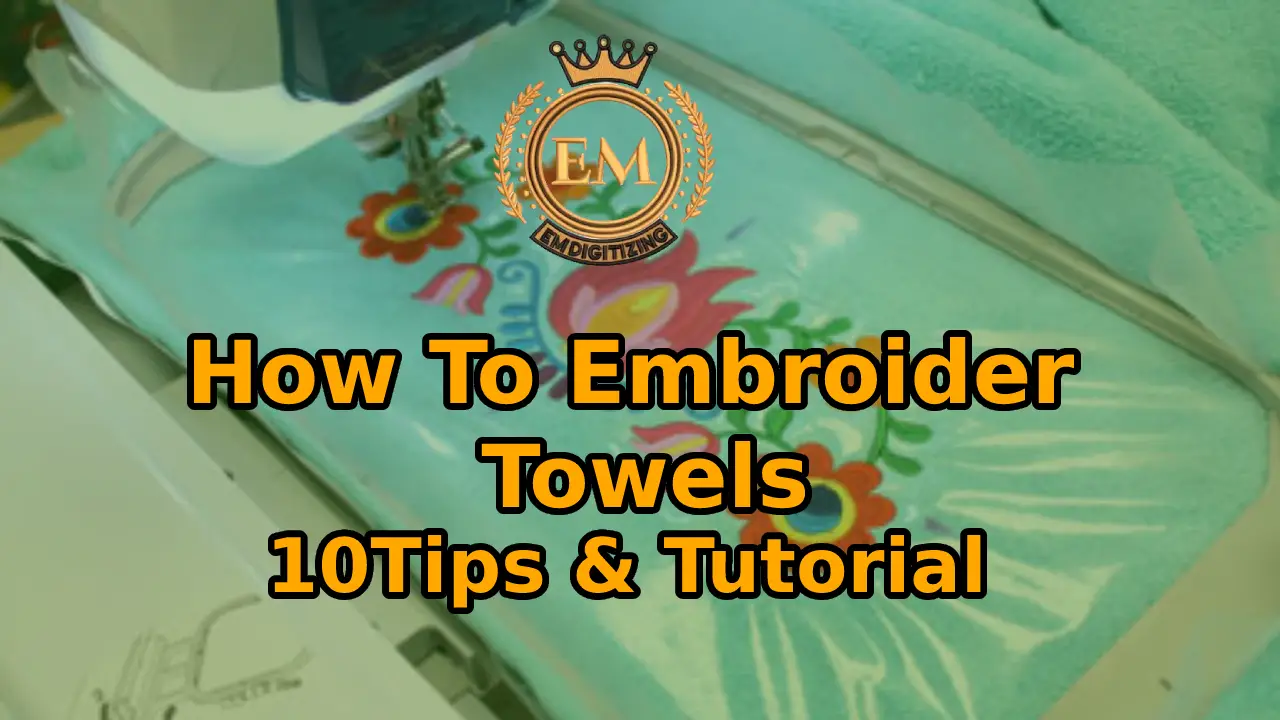
If you are a be on the wall of my house, you may be under the impression that my children are living in a homeless shelter based on the way they complain about their towels. The problem is that they come out of my sewing room with a lot of monogrammed towels and then get used to seeing other people as gifts.
So, naturally, they are jealous of the towel and ask to join the action. I will use this opportunity to start my holiday sewing and show you all how to embroider on towels.
Why embroider on towels?
If you are a beginner at machine embroidery, towels are a great start. Towels are flat which makes them easy to swim on a piece of hoop stabilizer. When you are embroidering, you do not have to struggle to keep the extra material out of the way.
Towels are cheap
Towels are also quite cheap, especially if you start with dollar store kitchen towels. If you are confused – it’s not a big deal. You can even get bath towels very cheap. Walmart and Marshalls sell bath towels for about $ 7 or $ 8.
Embroidered towels are a great gift
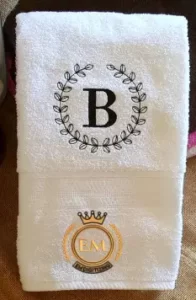
Towels are also a great gift. Especially suitable for wedding and engagement gifts. A newlywed or engaged couple would love to see their initials together on anything, so you really can’t go wrong with giving away a set of monogrammed towels.
Kitchen towels can also be a great gift for a host or hostess with a funny or seasonal embroidery design. I’d like to sew seasonal embroidery designs on some kitchen towels and then add my recipient’s last name below for a completely customized and personalized touch.
Embroidery Digitizing Services
Tips for Embroidering on Towels
If you want to jump into towel embroidery, we’ve compiled a list of our best tips for embroidering towels. Embroiderers of all levels must find something to learn. Let’s jump straight in!
1. Wash and Dry your Towel
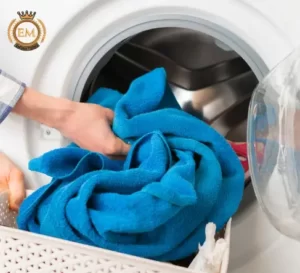
Most towels don’t shrink too much when you wash them, but it is possible, especially if they are made of cotton. That’s why I recommend that you wash and dry your towels before embroidering.
It takes care of shrinkage and washes away any excess dyes or chemicals used during the manufacturing process. If you sew a lot, pre-sifting the fabric may not be a new idea for you, but don’t forget that it also applies to the embroidery spaces you have purchased.
2. Choose a design with solid stitching
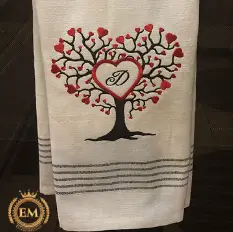 These are better because delicate or thin stitches will get lost in the texture of the towel! In addition, the solid pattern and stitching are more stable and better suited to traditional clothing that comes with the towel. If you are going to use your towel (instead of just putting it on display) make sure you avoid delicate sewing designs.
These are better because delicate or thin stitches will get lost in the texture of the towel! In addition, the solid pattern and stitching are more stable and better suited to traditional clothing that comes with the towel. If you are going to use your towel (instead of just putting it on display) make sure you avoid delicate sewing designs.
3. Play with placements, and use what works for you!
For foolproof placement, place your design 4 inches above the lower border of your towel. This is standard placement for adults such as bath towels or beach towels and will look great when folded.
4. Use 11 or 14 size needles
A 14 needle is extra sharp and is perfect for penetrating without damaging the fabric. These are the sizes that are generally recommended but they are not universal. Instead, it is more appropriate to use these sizes as a starting point and widen or narrow them. Again, this is about trial and error and using what feels comfortable to you.
5. Use a cut-away stabilizer
While you can use basically any stabilizer for towels, using the cut-away stabilizer will give you maximum support as it is the strongest stabilizer available.
6. But there are alternatives
If you know that the back of your towel will be on display, some embroiderers prefer to use a tear remover stabilizer. The bits of your cut-off stabilizers will stick with your final project so if you don’t want a tear-off stabilizer is a better option. Click here for more information on our blog “Taking the Headache out of Embroidery Stabilizers” and download the free Stabilizer Guide.
7. Use water-soluble toppings
It is extremely suggested that you use a water-soluble topping. This is to make sure your stitches don’t get lost or sink into your towel. The topping will fit your design because your machine works. It is a clear plastic material that can be easily removed by tearing and then cleaning the residue with a damp cloth.
8. ‘Float’ your embroidery
Sometimes your towel can be so thick that you can’t hoop it together with your stabilizer and topping. To remedy this you can ‘break’ your towel over your hoop.
9. Use a spray-on adhesive
If you try to float your material, make sure you have a spray-on adhesive can in your hand! This will help keep all your layers in place and will not cause any hassle on your items. Note: Some embroiderers use pins instead. It all depends on the individual and their own preferences but many people think that sticky things are quick and easy!
10. Use the design template
This will ensure that your placement comes out perfectly. There are some templates that come with software and some that come with embroidery machines. If your software or machine does not come with the template, you can buy them or download the basic one from the internet. Your hatch embroidery software will allow you to print the design with references that you can use as a template.
How to Embroider a Towel
Now that we have some boring details, let’s move on to embroidery! (And, if you are completely new to embroidery, check out Machine Embroidery Basics for Beginners)
1. Make your own towel and mark the design
It is important to wash and towel your towels beforehand. Since I dry my towels warm and medium, I washed my towel like this in preparation.
If you have a tag on your towel, remove it or leave it on the back of the towel on the opposite side you decide to embroider.
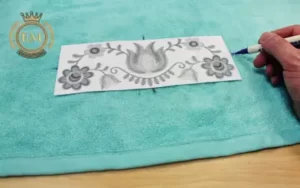
You also need to decide where you want your design on your towel. For embedded design, you can print the design from the software, cut it out, and then place it on top of the towel to locate the design. Since I have embroidered the initials and monograms on my towels in this tutorial, I have just marked the location by doing simple math and marking the center.
I mark the center of my embroidery design with a blue cloth pen, which will be washed with water once the embroidery is complete. The intersection of the two lines below will be the center of my monogram.
2. Stabilizing the towels
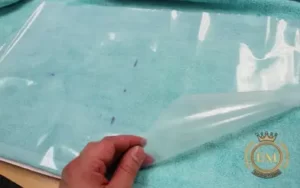 The choice of stabilizer depends on the desired use of your towel, the thickness of the towel, and the design you choose. In my experience, the best stabilizer for machine embroidery on towels is the medium-weight Tear-away Stabilizer. There is more information here, though.
The choice of stabilizer depends on the desired use of your towel, the thickness of the towel, and the design you choose. In my experience, the best stabilizer for machine embroidery on towels is the medium-weight Tear-away Stabilizer. There is more information here, though.
Types of stabilizers
All you need is a tear-away stabilizer, without stretching too much for thin and medium weight towels. When looking at the back of your towel, you will have no visible stabilizer left after your towel embroidery is complete.
Now, if you are embroidering beach towels or other towels that are unstable, you may want to consider a cutaway stabilizer or poly mesh. This will further support and further protect the integrity of your stitches. The only problem with the cutaway is that you have to cut it from the back of your design, and it will be visible from the back.
Stabilizer weight
You will also need to consider the weight of the stabilizer you will need: light, medium weight, or heavyweight. Choose the weight of the stabilizer based on the thickness and strength of your towel as well as the density of your design. I have used a medium-weight stabilizer for my towels in this tutorial.
Feasible vs Adhesive vs. Non-Feasible Stabilizer
Feasible stabilizers are attached to the back of your towel with an iron.
There is also an adhesive stabilizer, which sticks to the back like a sticker. It sometimes hurts the towel loop when I remove it, so I don’t like it for that purpose.
The non-fusible stabilizer can be applied using a temporary fabric adhesive. I prefer a temporary fabric adhesive non-feasible stabilizer, but every embroiderer has different preferences, and this is not a set-in-stone principle.
3. Adding Water-Soluble Topping
Any terry towel or towel with a nap requires a water-soluble topping or stabilizer.
This will strengthen the stitches and prevent them from sinking into the towel. And, one of the reasons you need a good, sharp needle for this project is that it will pierce this topping well. As I mentioned earlier, I am a big fan of Silky Solvay Stabilizer.
4. How to Hoop a Towel
If I can fit something into my hoop, I always hip it. In my experience, hopping provides more stability, and it’s easier for me to design embroidery designs inside the hoop. Hopping only works for thin towels.
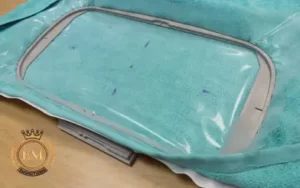 To attach everything, I first applied my tearaway stabilizer to the back of the towel using a very light layer of temporary fabric adhesive. Be careful not to soak the stabilizer or towel in the adhesive, otherwise, you will pull some loops from behind when you later remove your tears. You don’t have to use adhesive and some embroiderers hate it, but I think it prevents things from changing and gives better results.
To attach everything, I first applied my tearaway stabilizer to the back of the towel using a very light layer of temporary fabric adhesive. Be careful not to soak the stabilizer or towel in the adhesive, otherwise, you will pull some loops from behind when you later remove your tears. You don’t have to use adhesive and some embroiderers hate it, but I think it prevents things from changing and gives better results.
Wrap the stabilizer underneath, then the towel, and then the water-soluble topper as the top layer. If you can’t make a topping hoop, you can always put it on top of the hoop later.
5. How to float a towel
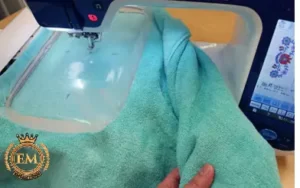
If you are unable to swing your towel due to thickness or preference, you can place it on top of your hooped stabilizer.
Ways to Prevent your towels from moving during embroidery Using self-adhesive adhesive stabilizers, adding a basting box, or even pinning in place.
6. Towel embroidery
Attach your hoop to your embroidery machine and arrange everything. Make sure the part of the towel that is not being embroidered is not under any part of your hoop.
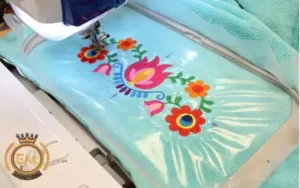 I would like to preview my design first with my machine where it is being sewn. This confirms that I have applied the design correctly. Every once in a while, after making a preview, I will realize that I have made the wrong measurement.
I would like to preview my design first with my machine where it is being sewn. This confirms that I have applied the design correctly. Every once in a while, after making a preview, I will realize that I have made the wrong measurement.
If all goes well, go ahead and start embroidering your towels!
7. Clean up
Once you have a towel, remove it from the hoop. If you hoop it safely, you’ll probably see hoop marks on the side. Don’t worry, towels are very flexible fabrics! These scars can be washed off, removed, or pressed with Magic Spray Sizing.
If you have jump stitches like the one below, go ahead and trim them if your machine doesn’t come automatically. Sometimes, when there is a water-soluble topping on the towel, it is easier to remove the jump stitches.
Then, to remove the water-soluble topping, tear it off. There is no need to be perfect about it. When you put your towel in water or in the first washing cycle, the rest will melt.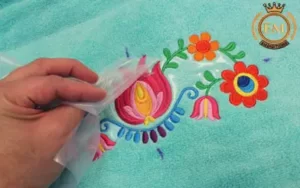
To remove the terrace stabilizer, gently tear it from the back. If you apply the stabilizer to the back of the towel, it may take a little longer. If you want to save small pieces from tearing, it will be a clean tear after your first wash. What does the back of my embroidered towel look like below?
And finally, if you mark with a water-soluble pen, it disappears when you dip your towel in water or wash it again.
Conclusion
Congratulations! Now you have successfully embroidered the towel. Go hang it proudly in your home or save it as a gift!
Enjoy Your Embroidered Towel.
Cutway stabilizer is the best choice for terry cloth towels. Sprinkle a piece of cutaway stabilizer with a temporary adhesive, then smooth the towel over. Use a water-soluble stabilizer topping to prevent the stitches from sinking into the fabric.
Just heat the iron to 320-355 degrees, apply fabric tape to your item and then place an extra piece of cloth on top, press the iron firmly on the cloth for 15-30 seconds, and remove the extra piece of cloth.
A small piece of masking tape and a permanent marker can be used throughout the click to label clothes. Write the name on the tape and stick it on the cloth. Cover the tape with a pressing cloth and then heat this covered tape with a dry iron for 10 to 15 seconds.
I either wrap (whip around the back of the stitches), or just pull the threads through the stitches, and take an extra backstitch at the back of the threads to anchor the thread. If you wish, you can read about it under Ending Embroidery Threads.
When monogramming washcloths and hand, bath, and beach towels, it is recommended to place the monogram between each one. Alternatively, some people add a monogram to a corner. For bath towels, the monogram is usually placed 4 inches above the hem or 1.5-2 inches from the border.
